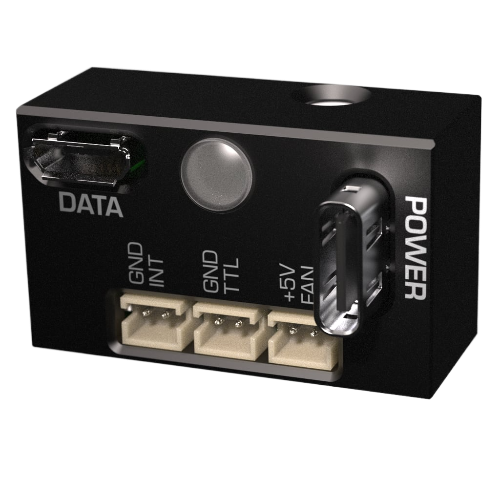785 nm SLM Laser
Item Code: 0785L-28A-NI-AT-NFDescription
Fiber Termination - FC/APC (AT): 8° polishing angle minimizes back reflections from fiber tip. This is necessary especially for SLM lasers.
Laser Rental
Rent a high-performance laser for a time-limited experiment. Or try several laser options before deciding, which to choose.
Success
Your request has been sent successfully. We'll get back to you as soon as possible.
Back to homepageRequest
Begin your product purchase process, with flexibility for customization based on your needs.
Success
Your request has been sent successfully. We'll get back to you as soon as possible.
Back to homepage| Parameter | Minimum Value | Typical Value | Maximum Value |
|---|---|---|---|
| Central wavelength, nm | 784.9 | 785 | 785.1 |
| Longitudinal modes | - | Single | - |
| Spectral line width FWHM, pm 1 | - | 5 | 1 |
| Output power, mW 2 | 5 | 80 | 90 |
| Side-mode suppression ratio (SMSR), dB | - | 50 | - |
| Power stability, % (RMS, 8 hrs) 3 | - | 0.2 | 1 |
| Power stability, % (peak-to-peak, 8 hrs) 4 | - | 2 | 3 |
| Intensity noise, % (RMS, 20 Hz to 20 MHz) 5 | - | 0.25 | 0.6 |
| Transversal modes | - | TEM00 | - |
| Polarization direction | - | Aligned with the slow axis of the PM fiber and the connector key. | - |
| Polarization extinction ratio (from PM fiber), dB | 20 | 23 | - |
| Control interface type 6 | - | UART | - |
| Operation mode | - | APC (CW) | - |
| Modulation bandwidth, MHz 7 | - | 10 | - |
| Input voltage, VDC | 4.8 | 5 | 5.3 |
| External power supply requirement | - | +5 V DC, 1.5 A | - |
| Dimensions (WxDxH), mm 8 | - | 50 x 30 x 18 | - |
| Fiber length, m | 0.95 | 1 | 1.1 |
| Heat-sinking requirement, °C/W | - | 1 | - |
| Optimum heatsink temperature, °C | 18 | 25 | 32 |
| Warm up time, mins (cold start) | 0.2 | 1 | 2 |
| Temperature stabilization | - | Internal TEC | - |
| Overheat protection | - | Yes | - |
| Storage temperature, °C (non-condensing) | -10 | - | 50 |
| Net weight, kg | 0.1 | 0.12 | 0.14 |
| Max. power consumption, W | 0.4 | 2 | 10 |
| Warranty, months (op. hrs) 9 | - | 14 (10000) | - |
| RoHS | - | Yes | - |
| CE compliance | - | - General Product Safety Directive (GPSD) 2001/95/EC - (EMC) Directive 2004/108/EC |
- |
| Laser safety class | - | 3B | - |
| OEM lasers are not compliant with | - | IEC60825-1:2014 (compliant using additional accessories) | - |
| Country of origin | - | Lithuania | - |
1 Measured with a scanning Fabry-Perot interferometer having 7.5 Mhz resolution, with scanning frequency of about 10 Hz. Interferometer testing is not provided for each laser being manufactured, the standard test is OSA measurement with 20-30 pm resolution instead.
2 Output power of FBG lasers can be changed with fairly good repeatability of spectrum.
3 The long term power test is carried out at constant laser body temperature (+/-0.1 °C) using an optical power meter with an input bandwidth of 10 Hz. The actual measurement rate has a period of about 20 seconds to 1 minute.
4 The long term power test is carried out at constant laser body temperature (+/-0.1 °C) using an optical power meter with an input bandwidth of 10 Hz. The actual measurement rate has a period of about 20 seconds to 1 minute.
5 Noise level is measured with a fast photodiode connected to an oscilloscope. The overall system bandwidth is from 2 kHz to 20 MHz.
6 Break-out-boxes AM-C8 and AM-C3 can be used for conversion of UART communication to either USB or RS232.
7 TTL digital modulation up to 10 MHz.
8 Excluding control interface pins and an output window/fiber assembly.
9 Whichever occurs first. The laser has an integrated operational hours counter.
Typical spectrum
Typical spectrum of 0785 nm diode laser. Measured with 20 pm resolution.

Drawing

Typical Near Field


Raman Spectroscopy
Raman Spectroscopy is a powerful analytical technique that explores molecular vibrations by measuring inelastic scattering of monochromatic light. It provides valuable insights into molecular structure, composition, and chemical bonding, making it widely used in material science, chemistry, and biology. The unique spectral fingerprints obtained through Raman spectroscopy enable non-destructive and precise identification of substances, making it a versatile tool for research and quality control applications.

Quantum Cryptography
Quantum cryptography is a way of securing information using the principles of quantum physics. One method of quantum cryptography is quantum key distribution (QKD), which allows two parties to share a secret key that can encrypt and decrypt messages. QKD uses entangled photons, which are pairs of light particles that have a quantum connection and share the same properties. By measuring the polarization of one photon, the other photon will have the same polarization, even if they are far apart. This way, the two parties can generate a random sequence of bits that form the key. However, to create and send entangled photons from space, they need small lasers that can fit into smallsats.
MatchBox Laser High-Performance Accessory Bundle

USB Break-out-Box for Single-Wavelength MatchBoxⓇ

RS232 Break-out-Box for Single-Wavelength MatchBox®

60W USB type C power supply

Air Cooled Heatsink With TEC

Stand-alone Air Cooled Heatsink With TEC

Compact TEC-Cooled Mounting Plate For MatchBox

Safety key box

Laser Safety Goggles for 200-400 nm, 765-1080 nm


